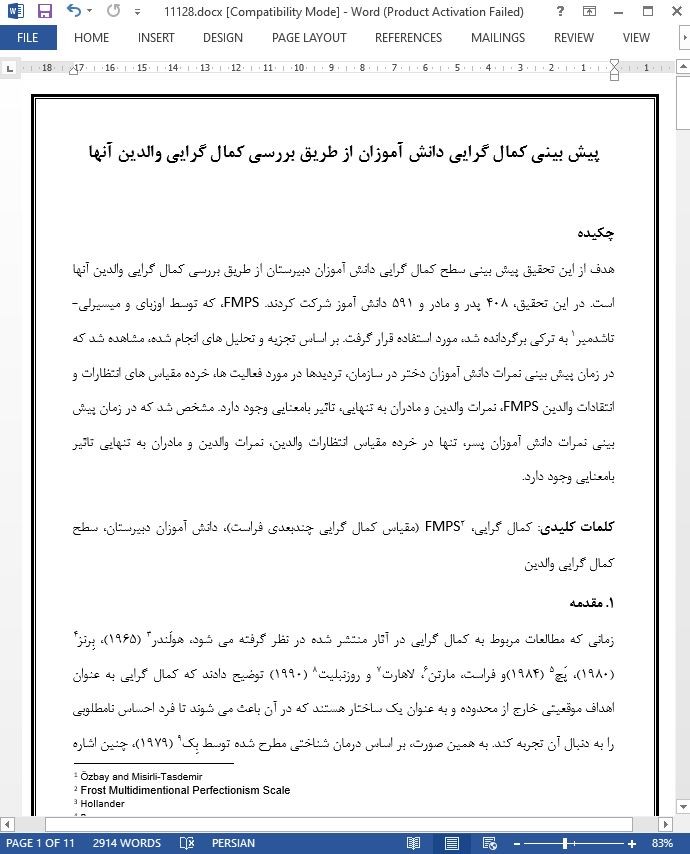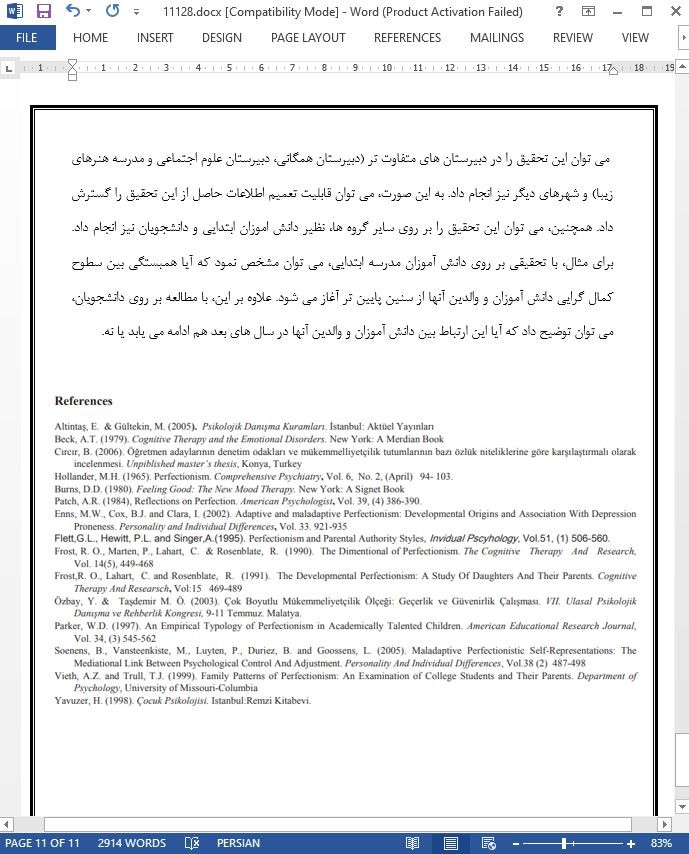
پیش بینی کمال گرایی دانش آموزان از طریق بررسی کمال گرایی والدین آنها
چکیده
هدف از این تحقیق پیش بینی سطح کمال گرایی دانش آموزان دبیرستان از طریق بررسی کمال گرایی والدین آنها است. در این تحقیق، 408 پدر و مادر و 591 دانش آموز شرکت کردند. FMPS، که توسط اوزبای و میسیرلی-تاشدمیر به ترکی برگردانده شد، مورد استفاده قرار گرفت. بر اساس تجزیه و تحلیل های انجام شده، مشاهده شد که در زمان پیش بینی نمرات دانش آموزان دختر در سازمان، تردیدها در مورد فعالیت ها، خرده مقیاس های انتظارات و انتقادات والدین FMPS، نمرات والدین و مادران به تنهایی، تاثیر بامعنایی وجود دارد. مشخص شد که در زمان پیش بینی نمرات دانش آموزان پسر، تنها در خرده مقیاس انتظارات والدین، نمرات والدین و مادران به تنهایی تاثیر بامعنایی وجود دارد.
1. مقدمه
زمانی که مطالعات مربوط به کمال گرایی در آثار منتشر شده در نظر گرفته می شود، هولَندر (1965)، بِرنز (1980)، پَچ (1984)و فراست، مارتن ، لاهارت و روزنبلیت (1990) توضیح دادند که کمال گرایی به عنوان اهداف موقعیتی خارج از محدوده و به عنوان یک ساختار هستند که در آن باعث می شوند تا فرد احساس نامطلوبی را به دنبال آن تجربه کند. به همین صورت، بر اساس درمان شناختی مطرح شده توسط بِک (1979)، چنین اشاره شده است تحریف های شناختی با ذهنی کمال گرا مرتبط هستند. باندورا ، بنیانگذار نظریه آموزش اجتماعی، چنین استدلال کرد که آموزش در محیطی اجتماعی روی می دهد و مهم ترین تجارب آموزشی کودکان مشاهده رفتار سایرین حاصل می شود. در این لحظه، تعریف و تمجیدهایی که والدین می کنند، همراه با تقلید کودکان از والدین، ممکن است در ایجاد کمال گرایی موثر باشند.
5. نتیجه گیری و توصیه
بر اساس این تحقیق، مشخص شد که در زمان پیش بینی نمرات دانش آموزان دختر در مورد خرده مقیاس های سازمان، ترددی در مورد فعالیت ها، انتظارات و انتقادات والدین و نمرات والدین و مادران به تنهایی تاثیر معناداری وجود دارد. مشخص شد که در زمان پیش بینی نمرات دانش آموزان پسر تنها در مورد خرده مقیاس انتظارات والدین، نمرات والدین و مادران به تنهایی تاثیر معناداری وجود دارد. می توان نتایج به دست آمده از این تحقیق را در سمینارهای آموزشی با خانواده ها به اشتراک گذاشت. به این صورت، والدین متوجه می شوند که خصوصیات آنها بر روی کودکان آنها اثر می گذارد. در این زمان، می توان به والدین کمک کرد تا خود را بهتر بشناسند تا مدل بهتری بوده و بهتر بتوانند با کودکان خود ارتباط برقرار کنند.
Abstract
The aim of this study is to predict the perfectionism level of secondary school students from their parents’ perfectionism. This study was performed with 408 parents and 591 students. FMPS, adapted to Turkish by Özbay and Mısırlı-Taşdemir, was used. According to the analyses; it was seen that there is a meaningful effect while predicting the scores of female students in Organization, Doubts About Actions, Parental Expectations and Parental Criticisms subscales of FMPS; scores of parents and mothers on its own. It was seen that there is a meaningful effect while predicting the male students’ scores only in Parental Expectation subscale; scores of parents and mothers on its own.
1. Introduction
When the studies about perfectionism are taken into account in literature, Hollander (1965), Burns (1980), Patch (1984) and Frost, Marten, Lahart and Rosenblate (1990) explained that perfectionism as setting goals that are out of range and as a structure in which it causes the person to experience negative feelings as a consequence. Likewise, according to the Cognitive Therapy introduced by Beck (1979), it was mentioned that “cognitive distortions” are related with perfectionist mind. Bandura, establisher of Social Learning Theory, argued that learning occurs in a social environment and most important learning experience of children happens by observing others’ behaviors. At this point, reinforcements and praises that the parents give might be effective in the development of perfectionism, together with imitations of parents by children.
5. Conclusion and Recommendation
According to the study; it was seen that there is a meaningful effect while predicting the scores of female students in Organization, Doubts About Actions, Parental Expectations and Parental Criticisms subscales of FMPS; scores of parents and mothers on its own. It was seen that there is a meaningful effect while predicting the male students’ scores only in Parental Expectation subscale; scores of parents and mothers on its own. These results obtained from the study can be shared with families in educational seminars. By this way, it might be provided that parents realize that these characteristics of themselves reflected over their children. At this point, parents can be helped for recognizing themselves better, for being better model and for how to communicate better with their children.
چکیده
1. مقدمه
2. روش
2.1. گروه مورد تحقیق
2.2. ابزار جمع آوری داده
2.3. پردازش
3. نتایج (یافته ها)
4. بحث
5. نتیجه گیری و توصیه
Abstract
1. Introduction
2. Method
2.1. Study Group
2.2. .Data Collection Instrument
2.3. Process
3. Results (Findings)
4. Discussion
5. Conclusion and Recommendation
- ترجمه فارسی مقاله با فرمت ورد (word) با قابلیت ویرایش، بدون آرم سایت ای ترجمه
- ترجمه فارسی مقاله با فرمت pdf، بدون آرم سایت ای ترجمه


